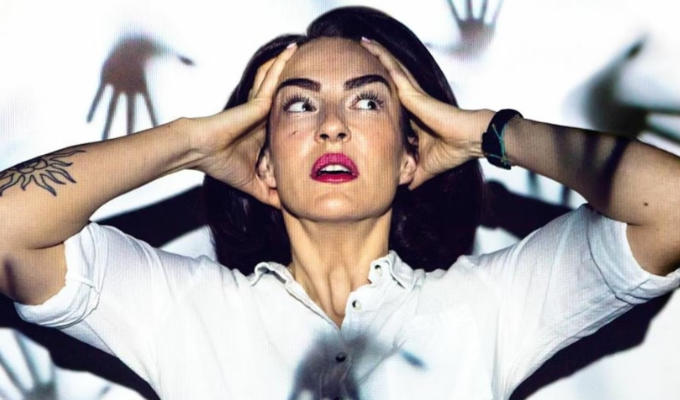Sketch comedy's not dead
...whatever Horne & Corden might do, writes Ian Hawkins
I have written in various formats for print and broadcast, and happily, have never been accused of being so bad at it as to have brought about the death of an entire genre. So I can scarce imagine how James Corden and Matt Horne must’ve felt the morning after their sketch show was broadcast when the Guardian’s headline ‘Is this the death of the TV comedy sketch show?’ assaulted them right between the croissants.Let’s be upfront: I’m not going to step down into the rut of Corden and Horne bashing, trodden smooth and deep as it is by the Converse All Stars of the critics. One: If I were a serious rival to them, it would look like I was trashing the competition. Two: As I’m not a serious rival, it looks like a tragic case of sour grapes.
Let’s just say that Corden and Horne sketches on Google Video carry a fair few four star ratings. As I’ve never rated a Google Video, even the dullest of detective sidekicks could deduce that I’m therefore probably not their audience.
So is the sketch format dying? No.
Sketches are victims of looking superficially easy: easy to write and easy to perform. Crucially, they’re also very easy to watch which might be the reason for the endurance of the format: it doesn’t matter how bad the sketch you’re watching happens to be, as it will be over shortly. If your expectations of the whole show are reasonably high, you can take a couple of stinkers in your stride.
Let’s take a couple of examples from sketch shows of impeccable pedigree.
The liberal Sxties swung through Round the Horne by Barry Took and Marty Feldman, though the format of the show had one foot firmly in the past. RTH occasionally came under pressure to clean up the scripts, though a quick listen is enough to demonstrate that either such demands were ignored, or that Kenneth Williams and Brian Paddick could still magic up a double entendre without the writers giving them one.
Controversy in the material was deftly sugarcoated by the central presence of Kenneth Horne who got apparently unlimited latitude from listeners and the BBC hierarchy. Sounding every inch the ex-RAF Wing Commander that he was, Horne steps through the madness that swirls around him, and is surprised, bemused, occasionally irritated, but never censorious or offended. And, somehow, the audience isn’t either.
And then there are the musical interludes. As Barry Took says in Round the Horne: The Complete And Utter History, the Fraser Hayes Four would come in and do a song mid-show, ‘so as to give the audience a break from laughing’. It’s a device that sounds like old hat now, yet the show is what it is, and it’s not until the last series, when cutbacks to the programme meant the cast sang their own songs, you realize that the maxim ‘leave them wanting more’ is a good rule to write by.
Structure is massively important in comedy. Stewart Lee tells a non-joke and greets the laughter it generates with a deconstruction of why it’s not funny, and why it got the reaction. I took a sketch show to Edinburgh, and my one of my favourite lines never got a laugh, simply because it occurred in a dialogue in which the preceding three lines also got laughs. (I’ve since resurrected the line for stand-up, and it gets the response it deserves. This might tell you something about the hiatus between laughs in my set.)
Anybody who has put a live sketch show together will know that tinkering with the running order throws up interesting questions about the nature of comedy: why does that previously-hilarious Taliban spoof suddenly seem in questionable taste? Why have audiences started laughing at the stuff we were about to cut? When the linking music went wrong last night – didn’t it sort of work better?
Let’s move on to the second example with impeccable pedigree: Monty Python.
I once went to an Evening With Terry Hughes, who directed the film of Monty Python Live at the Hollywood Bowl. At this stage of Python’s career parabola, there were so few surprises, the audience were more familiar with the material than the cast. Hughes explained an editorial decision I had sort-of-noticed, though without thinking about it too much. Being a concert film, there is a bit of footage of the house lights coming up for the interval. In real life this happened at half time. In the film, this happens two thirds of the way through, ‘so the audience is pleasantly surprised that the ending comes quicker than they expected.’
Python has always been about sketches; Grail and Brian are sketch films masquerading as narratives. Meaning Of Life, rightly or wrongly, is on fewer favourites lists, because it’s difficult to keep attending for that long to something that constantly subverts the previous scene.
The narrative arc of Meaning Of Life is not a personal story in the way that the others are. Even so, would putting together a three-hour two-film epic version of Brian with a CGI Graham Chapman be a case of diminishing returns? Perhaps John Cleese – post film-writing course – would agree.
You don’t need to go back to the Sixties and Seventie to find sketches thriving. Sure, it’s harder to stage than stand-up, but the fringe theatres of London and beyond regularly echo to the sound of laughter on a well-timed blackout. Idiots Of Ants and the House Of Windsor are two good examples who will doubtless be themselves referenced with impeccable credentials in 40 years time.
I would argue that the sketch show isn’t dead – but that the thirty minute slot shouldn’t be set in stone. Corden and Horne are appealing directly to an audience who are very comfortable with watching snippets of content between doing other things.
Why would that audience be interested in watching a half-hour lump of stuff? When else do they sit down and dedicate a full half hour to anything? Wouldn’t it make more sense to have the sketches in between other programmes, a bit of content to hold fickle viewers over the credits, a way of tempting Corden and Horne fans to stay watching until the next one?
A well-performed, tightly written sketch with a beginning, a middle and an end is a thing of beauty. It’s perfect for the internet and short attention spans. There’s room enough for both banquet and Pot Noodle. The sketch will be with us for a long time yet. The question is, do broadcasters have the imagination to deliver it in a way that will attract viewers?
Published: 30 Mar 2009






